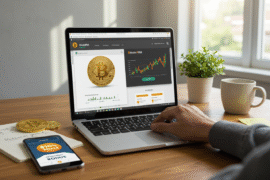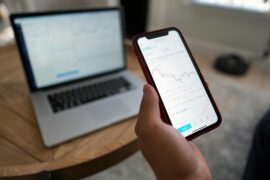This article may contain references to products or services from one or more of our advertisers or partners. We may receive compensation when you click on links to those products or services. Nonetheless, our opinions are our own.
The information presented in this article is accurate to the best of our knowledge at the time of publication. However, information is subject to change, and no guarantees are made about the continued accuracy or completeness of this content after its publication date.
- Key Highlights
- Introduction
- Understanding the Role of Liquidity Providers
- Types of Liquidity Providers
- Beginner’s Guide to Engaging with Liquidity Providers
- Step-by-Step Guide to Choosing a Liquidity Provider
- The Impact of Liquidity Providers on Market Efficiency
- Conclusion
-
Frequently Asked Questions
- What Makes a Good Liquidity Provider?
- What is a liquidity provider in the context of trading?
- How does a liquidity provider contribute to smooth trading operations?
- What are some benefits of using a liquidity provider for traders?
- Are there different types of liquidity providers available in the market?
- How can traders assess the reliability and efficiency of a liquidity provider?
- Recommended Reads
Key Highlights
- Liquidity providers are important in financial markets. They make trading easier and support a stable market.
- They work as market makers. They continuously give bid and ask prices for different financial products.
- There are several types of liquidity providers. This includes central banks, commercial banks, and other non-bank financial institutions.
- Choosing the right liquidity provider matters. It depends on your trading volume, how much risk you can take, and what the market needs.
- Liquidity providers help the market run better. They can lower trading costs, reduce slippage, and bring greater price stability.
Introduction
Liquidity providers are very important in a financial market. They make sure trading platforms have enough liquidity. This helps traders buy and sell assets easily. Without liquidity providers, trading would be more difficult. Markets would be more unstable, and costs would go up. So, how do these liquidity providers help with trading? Let’s examine this more closely.
Understanding the Role of Liquidity Providers
Liquidity providers help connect buyers and sellers in the market. They step in to buy or sell an asset, even when there are no other traders around. This means there is always someone ready to make a deal. Because of this, trading goes smoothly and happens fast.
They are like the oil that helps the financial markets work well. Their role is to make buying and selling assets easy. This helps avoid issues and keeps the market stable.
The Definition of Liquidity in Trading
Market liquidity is about how easy it is to buy or sell an asset quickly without making its price go up or down a lot. This depends on having enough buyers and sellers around to manage large trades without causing big price changes.
Liquid markets have small gaps between prices, lots of trading activity, and orders are filled quickly. In a liquid market, traders can enter and exit positions at favorable prices. They don’t need to worry about price changes or not getting their full order completed.
Illiquid markets show big differences between buy and sell prices. They often have low trading volume. This makes it hard to execute large trades. Because of low liquidity, prices can change quickly. This can lead to higher trading costs.
Why Liquidity Providers Are Essential for Markets
Liquidity providers are important for keeping the market stable. They help balance the buy and sell orders. This action helps to stop big changes in prices. Their job is especially key when the market is very volatile.
Having many liquidity providers leads to better prices. They compete against each other for trades. This competition makes the gap between buying and selling prices smaller. As a result, traders have lower trading costs and save money.
Liquidity providers boost trading activities. They make the market better and reduce slippage. This helps traders place larger orders at the prices they want. As a result, trading becomes more active and efficient.
Types of Liquidity Providers
Liquidity providers play different roles and have different goals. We can mainly group them into three categories: central banks, commercial banks and non-bank financial institutions, and high-frequency trading firms.
Central Banks as Liquidity Providers
Central banks are important for providing cash flow, especially in tough financial times. While commercial banks are there to earn money, central banks work to keep market stability. They do this by buying or selling government bonds and other financial products. This approach helps them change interest rates and control the money supply.
When central banks add more money to the market, they try to stop a credit crunch. A credit crunch is when banks and financial institutions become uneasy about lending money to one another. This concern can increase and negatively affect businesses and the economy.
Central bank intervention to provide liquidity is often the last option. It helps to build trust and lower big risks in the financial system. This shows how important it is to have a good level of liquidity. This is needed for smooth business operations and to keep the economy stable.
Commercial Banks and Non-Bank Financial Institutions
Commercial banks and non-bank financial institutions play a key role in giving liquidity in different financial markets. They support trading activities and help the buying and selling process run smoothly. Using their modern systems, they can manage large trades and deal with high trading volumes. This helps them to make big transactions without greatly impacting the market.
Institutional investors, such as hedge funds and asset managers, need liquidity providers. These providers help trades happen fast and lower the costs. By keeping a steady group of buyers and sellers, banks and firms strengthen the market and reduce slippage. This helps both retail and institutional traders.
Most of their profits come from the bid-ask spread. This is the gap between how much buyers are willing to pay and what sellers want. They want to make money, but they also help the market run better. Their work improves the trading experience for all the people involved.
Voted "Best Overall Budgeting App" by Forbes and WSJ
Monarch Money helps you budget, track spending, set goals, and plan your financial future—all in one app.
Get 50% OFF your first year with code MONARCHVIP
Beginner’s Guide to Engaging with Liquidity Providers
For traders, especially beginners, it’s important to understand liquidity providers. They have a major role in financial markets. When you know how they work, you can choose a better trading platform. You will also see how orders are completed and how to handle your trading costs.
This section explains the important points about working with liquidity providers easily. We will discuss the basics to help you begin. You will also learn how to figure out your liquidity needs. Finally, we will give you a simple step-by-step guide to help you find the right liquidity provider for your trading style.
What You Need to Get Started
First, choose a trading platform that allows you to connect with several liquidity providers. Make sure the platform follows strict rules and has strong risk management. This will help keep your investments safe.
Second, know the basic types of orders and market depth. Also, look at how liquidity can affect your trades. Learn about terms like slippage. Slippage happens when your order is completed at a lower price due to a lack of liquidity.
Before you start live trading, consider using a demo account first. A demo account allows you to practice in various market conditions. You will learn how liquidity affects your trades. This practice can help you develop skills to work well with liquidity providers.
Identifying Your Liquidity Needs
Your need for liquidity comes from several key factors. These include how much and how often you trade, your comfort level with risk, and the financial instruments you like. For example, high-frequency traders and asset managers with significant funds need access to deep liquidity pools. This helps them make large orders without affecting market prices significantly.
Think about the markets where you want to trade. Are you focusing on major currency pairs in the forex market? They have high liquidity. Or do you want to look at less liquid cryptocurrency markets? Knowing your target market can help you find the best liquidity providers for your needs.
Think about how much slippage and trading costs are okay for you. If price changes are important to you, find liquidity providers that have narrow spreads. They should also fill orders with very little slippage.
Step-by-Step Guide to Choosing a Liquidity Provider
Choosing the right liquidity provider is important for a good and profitable trading experience. A liquidity provider affects your trading costs and the speed of execution. It can also shape your feelings about the entire trading process. Picking the right one can help you keep successful trades from turning into losses.
This simple guide will help you understand what to think about when looking at different liquidity providers. With this info, you can make a good choice that fits your trading goals.
Step 1: Assessing Your Trading Volume and Needs
Before you check out different liquidity providers, it’s important to know what you need. Do you want high liquidity for one specific asset? What is your normal trading volume? How often do you trade?
If you trade often, especially in busy markets, you need a liquidity provider. This provider should manage large trades without making big price changes. Look for providers that have a good track record of handling large trades well. They should keep spreads tight, even when the market is active.
If you trade small amounts, you should find providers that have better fees and commissions. In this case, liquidity may not matter as much. You can focus more on saving money while still making good trades.
Step 2: Evaluating Liquidity Provider Offers
Once you know what you need for trading, begin to compare offers from different liquidity providers. Check how deep their liquidity pools are. Look at the financial instruments they have. Also, pay attention to how fast they execute trades and what fees they charge.
Carefully read the terms of service. Watch for any conflicts of interest, hidden fees, or limits on trading strategies. Good liquidity providers are honest about what they do. They share clear information with their clients.
Choosing the right liquidity provider is different for everyone. You should find a provider that matches your risk level, trading style, and goals for the future. If you have any questions or need more information about their offerings, don’t hesitate to reach out to their customer support.
The Impact of Liquidity Providers on Market Efficiency
Liquidity providers play a key role in keeping markets running smoothly. They allow for easy trades and help ensure the market is stable and clear for all market participants. Their impact on the market is large and important. They influence trading costs, the speed of trades, and the overall health of the market.
Liquidity providers play a key role in making trading better. They help create a smooth trading environment. This supports both individual traders and institutional investors.
Enhancing Trading Speed and Reducing Costs
Liquidity providers play a key role in keeping trading costs down. They do this by reducing the bid-ask spread. The bid-ask spread is the difference between what a buyer wants to pay (bid) and what a seller will accept (ask). When there is more liquidity, these spreads become smaller. This leads to lower trading costs for market participants.
Their presence lowers market volatility. When there is doubt or big orders, prices can shift fast. Liquidity providers help stabilize the market. They achieve this by taking on more buying or selling actions. This helps to stop major price changes.
This stabilizing effect is good for traders. It makes it easier for them to exit positions and get better prices, even when market volatility is high. This results in a smoother trading experience. Traders face less slippage and have more predictability in how trades are executed.
Improving Market Depth and Stability
Market depth tells us how many buy and sell orders exist at different prices in the order book. A high market depth means there is more liquidity. This allows large orders to be made without changing the asset’s price much. Liquidity providers help create this depth by regularly offering buy and sell orders. They act as a counterparty to other market participants.
Stable prices are important for a good market. They help investors feel safe over time. Liquidity providers are key in maintaining stable prices. They help reduce the price changes that happen because of supply and demand.
Their job is to make sure that big buy or sell orders can find enough liquidity. This helps to avoid big price swings that can upset the market. With this stability, trading is easier to predict and less dangerous. This makes more people want to join in and helps the market grow over time.
Conclusion
Liquidity providers play a key role in keeping the market stable and efficient. They help connect traders by providing enough buy and sell orders for smooth trading. To work well with a liquidity provider, you should know your trading volume and what you want. Take time to review offers closely and find the right liquidity provider for your needs. Good liquidity providers can speed up trading, lower costs, and improve market depth. Whether you partner with central banks or commercial institutions, the right liquidity provider can enhance your trading experience. Stay informed and make wise choices to better your trading journey.
Frequently Asked Questions
What Makes a Good Liquidity Provider?
A good liquidity provider has a strong history. They offer competitive prices and maintain high liquidity for different financial assets. They also adhere to regulatory compliance standards.
What is a liquidity provider in the context of trading?
A liquidity provider helps people trade on platforms like the forex market or a crypto exchange. They offer different financial assets for buying or selling. This ensures there is enough liquidity in the financial market.
How does a liquidity provider contribute to smooth trading operations?
Liquidity providers play a key role in market liquidity. They work as market makers. This means trades occur more quickly and pricing gets better. They also help keep the order book full and prepared.
What are some benefits of using a liquidity provider for traders?
Traders want to access deep liquidity pools. They prefer lower trading costs and tighter spreads. This leads to better execution quality. This holds even when market conditions are very volatile.
Are there different types of liquidity providers available in the market?
Different markets have unique sources of liquidity. These sources are central banks, forex brokers, crypto exchanges, and non-bank financial companies.
How can traders assess the reliability and efficiency of a liquidity provider?
Look for a reliable crypto liquidity provider. They should have a solid track record. Make sure they offer clear pricing. It is also important that they meet regulatory compliance. A strong reputation in the trading community is key as well.

Reviewed and edited by Albert Fang.
See a typo or want to suggest an edit/revision to the content? Use the contact us form to provide feedback.
At FangWallet, we value editorial integrity and open collaboration in curating quality content for readers to enjoy. Much appreciated for the assist.
Did you like our article and find it insightful? We encourage sharing the article link with family and friends to benefit as well - better yet, sharing on social media. Thank you for the support! 🍉
Article Title: Liquidity Provider: The Backbone of Smooth Trading Explained
https://fangwallet.com/2025/03/08/liquidity-provider/The FangWallet Promise
FangWallet is an editorially independent resource - founded on breaking down challenging financial concepts for anyone to understand since 2014. While we adhere to editorial integrity, note that this post may contain references to products from our partners.
The FangWallet promise is always to have your best interest in mind and be transparent and honest about the financial picture.
Become an Insider

Subscribe to get a free daily budget planner printable to help get your money on track!
Make passive money the right way. No spam.
Editorial Disclaimer: The editorial content on this page is not provided by any of the companies mentioned. The opinions expressed here are the author's alone.
The content of this website is for informational purposes only and does not represent investment advice, or an offer or solicitation to buy or sell any security, investment, or product. Investors are encouraged to do their own due diligence, and, if necessary, consult professional advising before making any investment decisions. Investing involves a high degree of risk, and financial losses may occur including the potential loss of principal.
Source Citation References:
+ Inspo
There are no additional citations or references to note for this article at this time.












































